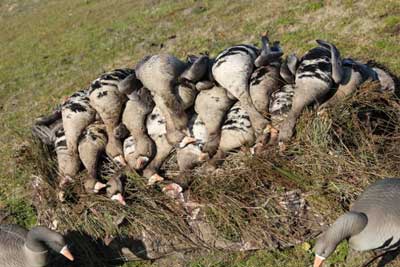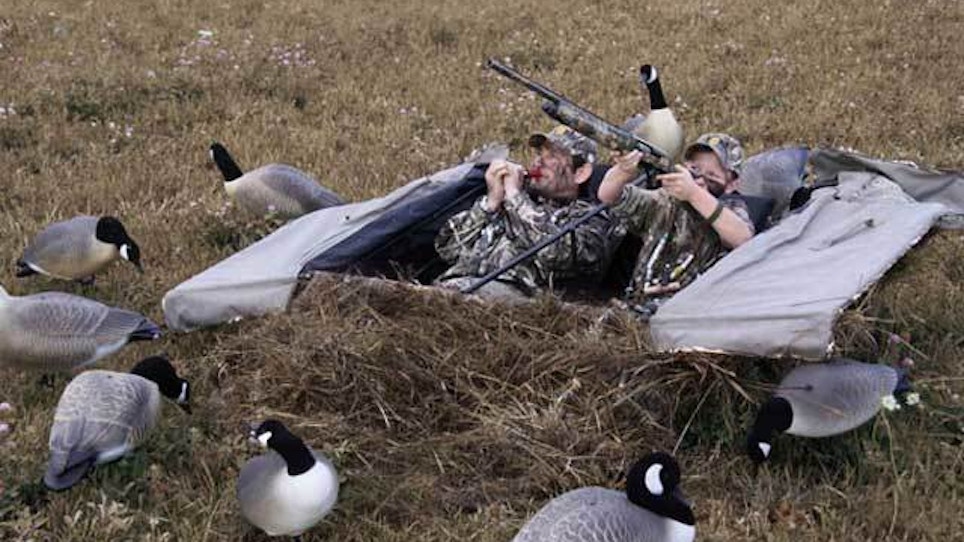Derrek Sigler, Hard Core Decoys
You finally broke down, stepped up to the plate and smacked a home run by buying a layout blind. You've gone through the break-in steps, laying on a thick layer of mud, letting it dry and then shaking it off to kill the UV glare. Now you're ready to head out and hunt, right? Nope. There's more to it than that.
Camo is a great thing and it really has changed how we hunt. Some of today's patterns are truly amazing, but even the best camo pattern in the world isn't enough to fool waterfowl. You need to do more to hide yourself when hunting, and that is why blinds, like the Hard Core Man Cave shown here, have stubble straps built in.
Matching The Hatch
I know, that's a fly-fishing term, but it fits. In fly-fishing, you want to match the insects that are emerging at that time. The same goes for brushing blinds. You don't want to hunt a green winter wheat field with a blind covered in corn stalk colors. It'll stand out like Miley Cyrus at Phil Robertson's house.
Your blind has a lot of stubble straps. Use them! I start out every season going through and starting with a "base layer" of blind material. I like to use fresh hay from my field. I don't try to cover the whole blind, but I do try to give a good, solid layer I can build on when I hit the field.
I used to try to bush the blind in completely when I was in the field. This never worked right because I never had enough time between setting decoys and drinking coffee. The first year I hunted with a layout, I noticed that as the season went along and more and more brush was added to the blind, the more success I had. Might as well start off that way, right?
So with my base layer in place, I take a good look at the conditions I'm hunting in. Early season, for me, means hunting fresh-cut alfalfa fields and some occasional oat fields. While these two plants look similar from a distance, up close, they aren't close at all, so you have to be aware of that.
Another factor in matching the growth is the rainfall. You can plan to hunt green fields, but if the rain doesn't fall and you have a scorching hot August, you'll be hunting in a lot of brown, dormant grasses in early goose season. It doesn't take much rain, however, to green a field quickly. I've started prepping blinds only to have a weekend of rain and sun turn brown to green fast.
One way around this is to have a good supply of artificial blind material with you. Hard Core EZ Grass is available in several color combinations and can easily fill in when local foliage is hard to come by.
 Cornfields
Cornfields
Cornfields are another animal. Hunting in corn stubble can make your brushing job easy, especially if you were smart enough to go and grab enough stalks before they are all shopped up. I'm not above stopping into a local store and buying a bundle of stalks that folks use for decoration.
Blending your blind into a corn stubble field is trickier than you might think, though. Sure, you can cover your blind up pretty quickly and easily with stalks and be concealed, right? But are you really concealed? Try to look at it from the perspective of a goose. You've got this field that looks right. There's a pile of your friends down there, feeding in the rows of stubble. But what is that big pile of stubble right there in the middle? See what I'm getting at?
Cornfields are planted in rows and have a symmetrical look to them. Don't break the symmetry! I like to place my blind between the rows as best I can. I line sides heavily with corn stalk stubble and I try to keep the center of my blind darker, with sparse vegetation. When I know I'm going to hunt cut corn, I'll often lay on a layer of mud, just like when I was breaking the blind in. Of course, you want to do this well enough in advance so it dries. A trick if you're in the field is to simply grab a big handful of dirt and rub it into the material.
Tools Of The Trade
I like to take a camera with me when I'm scouting. You should always have a camera with you, right? In addition to taking pictures of birds, deer and other cool stuff, I'll take some good close-up shots of the ground to use as a base for starting the brushing process.
Hard Core has a line of tools to help you brush your blind, too. Everything from nippers to ratcheting pruners and even a machete is currently available at a retailer near you. The Hard Core Blind bags are even designed with a pocket for your nippers.
"I designed the bag with a pocket especially for your pruners/nippers, because one of the first things you do when you get in the field is touch up the blinds," said Hard Core's Mike Galloway.
Snowblind
Concealing a blind in winter can be easy, right? Hold on. Yes, the best and easiest thing to do is get a snow cover for your blind. Putting on a snow cover is not the end of the discussion, though. You still need to stubble the blind accordingly. I also like to pile some extra snow around the blind. Not only does this help blend it in, but snow is a great insulator. When I'm hunting the deep freeze of a late-season hunt, I want all the help I can get staying warm.






